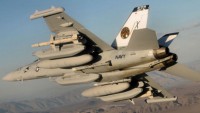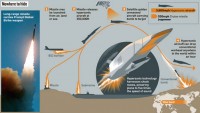Russian Experts Pooh-Pooh US Hypersonic Glide Vehicle Program
| Arthur Dominic Villasanta | | Sep 23, 2016 08:00 PM EDT |
(Photo : DARPA) HGV concept from DARPA.
Experts from Russia's aerospace industry are questioning if the United States can really focus on developing a single family of hypersonic glide vehicles (HGVs) given its plethora of either failed or discontinued projects of this kind over the past decades.
The latest in this long line of U.S. HGV projects is a contract worth $147.3 million recently awarded to Lockheed Martin Corporation by the U.S. Defense Advanced Research Projects Agency (DARPA) for research work under the Tactical Boost Glide (TBG) program.
Like Us on Facebook
Lockheed Martin will conduct research on a hypersonic TBG aircraft to develop technologies that facilitate the production of air-launched, tactical-range hypersonic boost glide systems capable of reaching Mach 5 (6,000 km/h) and beyond. TBG will enable the U.S. to counter increasingly advanced threats during offensive strike operations.
Dr. Greg Zacharias, Chief Scientist of the United States Air Force, said the Air Force expects to add a few hypersonic weapons to its fleet by the 2020s. By the 2030s, the air force anticipates having a hypersonic drone or ISR (intelligence, surveillance, reconnaissance) vehicle.
By the 2040s, it will have an operational hypersonic strike ISR platform capable of both surveillance and weapon delivery.
The TBG program is a joint DARPA/U.S. Air Force effort that aims to develop and demonstrate technologies to enable future air-launched, tactical-range hypersonic boost glide systems. In a boost glide system, a rocket accelerates its payload to high speeds. The payload then separates from the rocket and glides unpowered to its destination.
Not impressive, said Russian analysts who question if the U.S. will really be able to develop an operational HGV.
Anton Mardasov, a columnist for Svobodnaya Pressa (a Russian internet magazine), listed down previous U.S. HGV projects. These include the X-43 spaceplane developed by NASA; the X-51A missile from the Air Force; the Advanced Hypersonic Weapon (AHW) glide vehicle for use by the U.S. Army; the ArcLight rocket developed by DARPA and the U.S. Navy and the Falcon HTV-2 glider from DARPA and the Air Force.
Then there's the Prompt Global Strike (PGS) program aiming for a system that can deliver a precision-guided conventional weapon airstrike anywhere in the world within one hour. Such a weapon might also be useful during a nuclear conflict, and replace the use of nuclear weapons against 30% of targets.
The PGS program encompasses conventional surface-launched missiles and air- and submarine-launched hypersonic missiles. Unlike both China and Russia, however, the U.S. has said its hypersonic warheads or hypersonic glide vehicles won't pack nuclear warheads.
Mardasov said TBG uses technologies developed for HTV-2 project, "and that TBG assumes the creation of hypersonic means to deliver a payload not just from air-based systems, but from land-based one, as well."
He noted the TBG program envisions an aircraft and not a rocket lofting an HGV into the atmosphere.
"And as we know, testing of the X-51A missiles using the B-52 bomber in 2010 and 2011 could hardly be called successful, given problems with the unit's ramjet engine."
Military analyst Viktor Murakhovsky said PGS is meant to help develop and iron out technologies that can later be used on land-based systems and also for hypersonic missile warheads.
"It must be said that the U.S. has many projects of this kind," said Murakhovsky.
"They include the AHW, Falcon ... a paper project to create a hypersonic twin-engine reconnaissance aircraft (the SR-72) and others. But no one, not even the Americans, has actually developed an air- or land-based pre-production model" of such a system.
Airfoils with aerodynamic characteristics are difficult to control at high speeds, he said. There are other problems such as maintaining communication with vehicles moving at such speeds when the craft is essentially moving inside a plasma cocoon.
Tagshypersonic glide vehicles, HGV, Defense Advanced Research Projects Agency, DARPA, Tactical Boost Glide (TBG) program, Dr. Greg Zacharias, U.S. Air Force
©2015 Chinatopix All rights reserved. Do not reproduce without permission
 DARPA Launches Contest to Make AI-powered Military Radios that are Really Smart
DARPA Launches Contest to Make AI-powered Military Radios that are Really Smart DARPA Developing Next Gen US Electronic Warfare Systems Masterminded by AI
DARPA Developing Next Gen US Electronic Warfare Systems Masterminded by AI DIUx, DARPA’s Baby Brother, Shares Role of Keeping US Military the World’s Most Powerful
DIUx, DARPA’s Baby Brother, Shares Role of Keeping US Military the World’s Most Powerful US Outspending China and Russia in Hypersonic Weapons Research
US Outspending China and Russia in Hypersonic Weapons Research
EDITOR'S PICKS
-

Did the Trump administration just announce plans for a trade war with ‘hostile’ China and Russia?
-

US Senate passes Taiwan travel bill slammed by China
-

As Yan Sihong’s family grieves, here are other Chinese students who went missing abroad. Some have never been found
-

Beijing blasts Western critics who ‘smear China’ with the term sharp power
-

China Envoy Seeks to Defuse Tensions With U.S. as a Trade War Brews
-

Singapore's Deputy PM Provides Bitcoin Vote of Confidence Amid China's Blanket Bans
-

China warns investors over risks in overseas virtual currency trading
-

Chinese government most trustworthy: survey
-

Kashima Antlers On Course For Back-To-Back Titles
MOST POPULAR
LATEST NEWS
Zhou Yongkang: China's Former Security Chief Sentenced to Life in Prison

China's former Chief of the Ministry of Public Security, Zhou Yongkang, has been given a life sentence after he was found guilty of abusing his office, bribery and deliberately ... Full Article
TRENDING STORY

China Pork Prices Expected to Stabilize As The Supplies Recover

Elephone P9000 Smartphone is now on Sale on Amazon India

There's a Big Chance Cliffhangers Won't Still Be Resolved When Grey's Anatomy Season 13 Returns

Supreme Court Ruled on Samsung vs Apple Dispute for Patent Infringement

Microsoft Surface Pro 5 Rumors and Release Date: What is the Latest?










